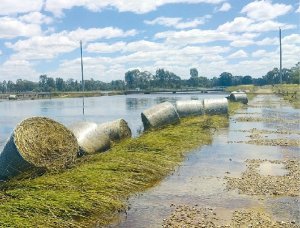There are many problems associated with flooding, the most immediate ones such as lameness and mastitis are obvious, so the level of response is generally quite good. But there are some potentially serious problems, less immediate and potentially more devastating.
Problems with parasites, (worms, coccidia and fluke) are more likely to occur after wet conditions, so it is essential farmers anticipate this and plan to deal with it by strategic drenching. In many areas, April is the ideal time to drench cattle to reduce the numbers of worms and hence pasture contamination.
At the recent Australian Cattle Vets conference, a paper was presented that showed significant losses of production can occur even with low levels of worm eggs in the faeces.
Dairy producers also need to be aware of the potential for significant losses from another disease that is barely on the radar for most dairy herds – botulism. There is no specific treatment for botulism, and most animals that go down will either die or need to be humanely destroyed.
Botulism vaccination, in my experience, is infrequently used in most southern Australian dairy herds, yet the potential for huge losses is real and much higher after flooding. This is because, to a large extent, the sale of vaccines is controlled by rural stores which sell these products close to cost price, relying on sales volume, discounts, manufacturer rebates and ‘trinkets’ (Eskys, porch heaters, etc) to prompt buying decisions. This means there has been less and less involvement of veterinarians in advising what vaccine is actually best for a herd.
There are a number of reasons why botulism is more likely after flooding. Botulism is caused by a toxin produced from the vegetative state of the organism, clostridium botulinum. Clostridium species, often better known for diseases such as blackleg or enterotoxaemia, are spore-forming bacteria. This means they can produce a dormant spore which can survive for long times in the environment.
Clostridium botulinum can be found in soils, sediments and the gut contents of fish or animals. The bacteria themselves are not really dangerous; it is the toxin they produce under the right conditions that can be fatal. Botulinum toxin causes paralysis of muscles and is the active ingredient in botox.
The muscle paralysis causes the smoothing of crows’ feet when used in tiny doses in the faces of humans. It also causes severe disease and frequently devastating losses in cattle if they eat large amounts of toxin.
Botulism is considered typically a northern Australian disease, seen in the vast cattle properties where phosphorous deficiency is common, and cattle get botulism from chewing on bones contaminated with the toxin.
However, as dairy farms become more intensive, and large amounts of silage is fed, the risk of botulism increases markedly.
After flooding the problem is worse. Rotting vegetable matter can contaminate sources of drinking water; sediments are likely to have contaminated stored feed which due to flooding may become spoiled; and there is a higher likelihood of dead animals and fish being left behind by floodwater in paddocks from which silage will be made.
• Rob Bonanno is president of the Australian Cattle Veterinarians Association and a director of the Shepparton Veterinary Clinic.
















